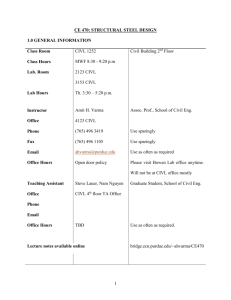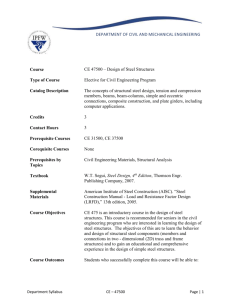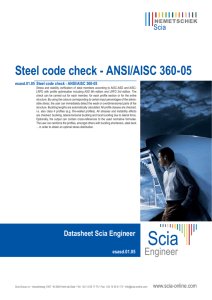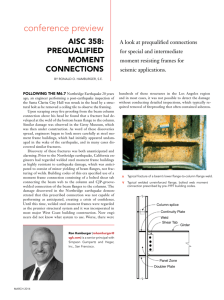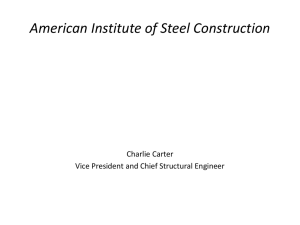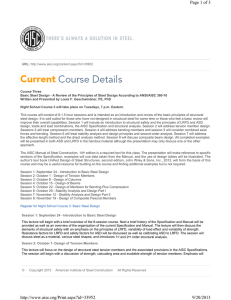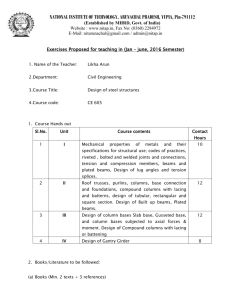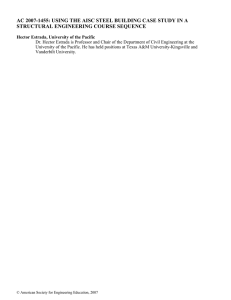outline - College of Engineering
advertisement
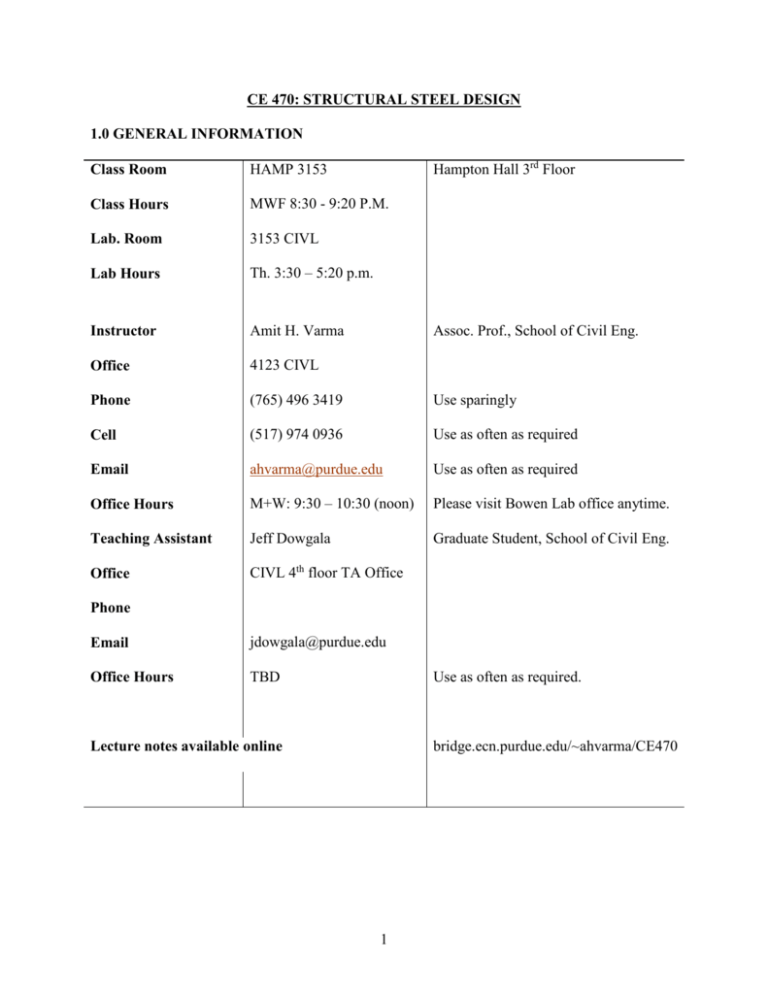
CE 470: STRUCTURAL STEEL DESIGN 1.0 GENERAL INFORMATION Hampton Hall 3rd Floor Class Room HAMP 3153 Class Hours MWF 8:30 - 9:20 P.M. Lab. Room 3153 CIVL Lab Hours Th. 3:30 – 5:20 p.m. Instructor Amit H. Varma Office 4123 CIVL Phone (765) 496 3419 Use sparingly Cell (517) 974 0936 Use as often as required Email ahvarma@purdue.edu Use as often as required Office Hours M+W: 9:30 – 10:30 (noon) Please visit Bowen Lab office anytime. Teaching Assistant Jeff Dowgala Graduate Student, School of Civil Eng. Office CIVL 4th floor TA Office Assoc. Prof., School of Civil Eng. Phone Email jdowgala@purdue.edu Office Hours TBD Use as often as required. bridge.ecn.purdue.edu/~ahvarma/CE470 Lecture notes available online 1 2.0 COURSE OBJECTIVES CE470 is an introductory course in the design of steel structures. This course is recommended for seniors in the civil engineering program at Purdue University who are interested in learning the design of steel structures. The objectives of this course are: 1. To learn the behavior and design of structural steel components, for example, members and connections in two - dimensional (2D) truss and frame structures. 2. To gain an educational and comprehensive experience in the design of simple steel structures. 3.0 COURSE MATERIAL AND REFERENCES 1. The course will follow the contents of the book: Segui, W.T. (2012). LRFD Steel Design. 5th Edition, Brooks/Cole Publishing Company, Pacific Grove, California. 2. Steel structures will be designed according to: AISC (2010). Specification for Structural Steel Buildings, American Institute of Steel Construction, Chicago, IL. 3. Specific structural steel components will be selected using: AISC (2010). Steel Construction Manual, Fourteenth Edition, American Institute of Steel Construction, Chicago, IL. 4. Some other books and references on the behavior and design of steel structures that are on reserve in the library are: 2 a) Salmon, C.G. and Johnson, J.E. (1996). Steel Structures: Design and Behavior, Emphasizing Load and Resistance Factor Design, 4th Edition, Harper College Publishers, New York, NY. b) ASCE/SEI 7-10. (2010). Minimum Design Loads for Buildings and Other Structures. American Society of Civil Engineers. Reston, VA c) IBC (2012). International Building Code, International Code Council. Falls Church, VA. d) The software that will be preferred for analyzing structures in this course will be Mastan 2, which can be downloaded from www.mastan2.com for free. OR SAP 2000 can be used 4.0 COURSE FRAMEWORK 1. CE 470 will consist of 16 weeks of lectures (including holidays and breaks). In all there will be 29 lectures and 15 lab periods. 2. Students will be assigned homeworks, exams, and a group design project. 3. The final grades will be based on the homeworks, exams, and design project as follows: Homeworks and Labs Exams = 29.4 % = 70.6% (23.53% x 3) 4. The final grades will be assigned on a straight scale, with some adjustment for the level of difficulty of the exams and overall class performance. If no adjustments are required then the final grades will be assigned as follows: Score 90 4.0 (A) 70 Score < 80 2.0 (C) Score 60 0.0 (F) 80 Score < 90 3.0 (B) 60 Score < 70 1.0 (D) Is there interest in + or – grades? 3 5.0 COURSE POLICIES 1. Attendance policy - Students are expected to attend all the lectures and laboratory sessions. They are also expected to perform all the work assigned by the instructor and the TA. 2. Tardy policy - All the assigned work must be submitted by the due date and time. Submissions that are 0 - 24 hours late will be penalized for 25% of the grade. Submissions that are 24 - 48 hours late will be penalized for 50% of the grade. After 48 hours, submissions will neither be accepted nor graded. Exceptions can be made for students with emergencies or special circumstances. 3. Make-up policy - Students are expected to take the exams on the assigned dates and times. Make-up exams may be arranged for students with emergencies or special circumstances. 4. Quality of Submissions - Students are encouraged to submit their work on engineering paper or clean white paper. Please explain and show all your calculations. Include appropriate references to the AISC specifications and final drawings of designed structures. 6.0 RELEVANT UNIVERSITY POLICIES AND PROCEDURES 1. Academic integrity: is expected of all students at all times. Information on what constitutes academic integrity may be found in the handbook University Regulations and at the following URL: http://www.purdue.edu/odos/administration/dishonesty.htm 2. Please consult the Academic Calendar and the undergraduate students’ office to find the precise dates for dropping the course with full refund and no grade reported. 3. Religious Observance: If you wish to be absent from class to observe a religious holiday, make arrangements in advance with the instructor. 4 4. Missing Class to Participate in a Required Activity: To be excused from this class to participate in a required activity for another course or a university-sanctioned event, you must provide the instructor with adequate advanced notice and a written authorization from the faculty member of the other course or from a university administrator 5. Commercialized Lecture Notes: Commercialization of lecture notes and university-provided course materials is not permitted in this course. 7.0 IMPORTANT DATES Classes begin Monday, August 19, 2013 Holiday – University closed Monday, September 2, 2013 October Break Monday-Tuesday, October 7-8,2013 Holiday – University closed Wednesday-Saturday, November 27-30,2013 Classes end Saturday, December 7,2013 Final Exam 5 8.0 COURSE SYLLABUS AND OUTLINE Chapter 1. Estimating design forces for members of a structure (1 week) Given the structural layout, plan, and elevations of a 3D structure, the student learns to: (1) Identify the types of 2D structural frames that are assembled in to the 3D structure, (2) Determine the nominal dead loads, live loads, snow and roof loads, and wind loads acting on the 3D structure. (3) Distribute the nominal loads to the 2D structural frames of the 3D structure (4) Perform linear-elastic structural analysis to determine the internal axial, shear, and bending moments in all the members of the 2D frames (5) Identify the design forces and moments for all members of the 2D frames Chapter 2: Designing tension members (3 weeks) Given the design tension force for a member the student learns to: (1) Calculate the gross yield strength of a tension member (2) Calculate the net section fracture strength of the tension members (3) Calculate the effective net area of the tension members (4) Calculate the block shear rupture strength of a tension member (5) Design the tension member using the AISC-LRFD manual Chapter 3a: Designing bolted connections (2 weeks) In this section, the students learn: (1) The behavior and various possible failure modes for bolted connections (2) To calculate the shear strength, bearing strength, and minimum edge distance and spacing requirements for bolted connection 6 (3) To design a bolted connection and gusset plate for given design forces (4) The behavior of a slip-critical connection and how to calculate the slip-strength of a fully tensioned bolted connection (5) To design a slip-critical bolted splice connection for a tension member. Chapter 3b: Designing welded connections (1 week) In this section, the students learn: (1) Different types of welding procedures, welds, and welded connection (2) To calculate the shear strength of a fillet weld considering weld and base metal strength (3) To design a fillet welded connection considering issues such as minimum weld size, maximum weld size, etc. Chapter 4: Designing compression member or columns (3 weeks) In this section, the students learn: (1) The elastic and the inelastic buckling behavior of compression members or columns (2) To calculate the strength of a compression member depending on the end conditions (3) To design a compression member using the AISC manual (4) To determine the effective length of a compression member that is part of a frame using the alignment chart method (5) To design columns in braced or unbraced frames using the AISC manual. 7 Chapter 5a: Designing beams for flexural yielding (1 weeks) In this section, the students learn: (1) The behavior of a laterally supported beams subjected to flexural loading (2) To calculate the yield moment, elastic section modulus, plastic moment, and the plastic section modulus. (3) To calculate the design strength of a laterally supported beam (4) To design the beam using AISC manual to have adequate strength at factored load (5) To design the beam using AISC manual to have adequate stiffness at service loads Chapter 5b: Designing beams for lateral torsional buckling (2 weeks) In this section, the students learn: (1) The local buckling behavior of beams and the difference between slender, compact, and non-compact sections. (2) Design of beams considering the local buckling limit state using AISC manual (3) The lateral torsional buckling behavior of beams and the difference between slender, compact, and non-compact members. (4) Designing the beams considering lateral torsional buckling and the effects of moment gradient through the use of Cb and the AISC manual. Chapter 6: Designing beam-columns for combined axial and flexural forces (2 weeks) In this section, the students learn: (1) The axial load – bending moment (P-M) interaction curves for steel beam-column members. The effects of slenderness and moment diagram on beam-column strength. (2) The new procedure for selecting and checking beam-column member design. 8
